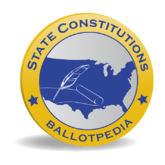Florida Constitution
| Florida Constitution |
|---|

|
| Preamble |
| Articles |
| I • II • III • IV • V • VI • VII • VIII • IX • X • XI • XII |
The Florida Constitution is the state constitution of Florida.
- The current Florida Constitution was adopted on November 5, 1968.[1]
- Florida has had six state constitutions.
- The current state constitution has 12 articles.
- The current constitution has been amended 144 times.[2]
- Voters last approved four new amendments to the Florida Constitution on November 3, 2020.
The Florida Constitution can be amended with a legislative, citizen-initiated, or covention-referred constitutional amendment, as well as through commission referrals from the Florida Constitution Revision Commission and the Florida Taxation and Budget Reform Commission. All of constitutional amendments in Florida require voter approval.
A state constitution is the fundamental document that outlines a state's framework for governance, including the powers, structure, and limitations of the state government, individual and civil rights, and other matters.
Background
Florida became the 27th state on March 3, 1845. Florida has had six constitutions adopted in the years 1812, 1838, 1861, 1868, and 1885, and 1968. The sixth and current version was ratified by voters at the November general election in 1968.[3][4]
In March 1812, Spanish East Florida was invaded by settlers from Georgia known as the Patriot Army. The group had support from the United States government to try to convince the inhabitants of the area to declare independence from Spain so that the United States might claim them as a territory. By early 2013, the federal government retracted their support, and the Patriot Army abandoned their cause.[4] The 1812 Patriot Constitution can be viewed here.
The 1838 Constitution was written so that Florida would be recognized as a state. The constitutional convention to establish this document began on December 3, 1838. The final version of this document can be viewed here.
In order to secede from the United States during the Civil War, Florida had to change its constitution. The revised constitution was adopted on January 10, 1861.[4]
In order to re-enter the United States, Florida drafted a new constitution. The first version of 1865 did not meet Congress' requirements and was rejected, with Congress placing Florida under Radical Reconstruction, or military rule until 1868.[5]The 1868 Constitution returned control of the state to civilians. Florida's 1885 Constitution reversed some aspects of the 1868 Constitution and established the form of state government that continued until 1968.[4]
Preamble
The Preamble to the Florida Constitution states:
Article I: "Declaration of Rights"
- See also: Article I, Florida Constitution
The Florida Constitution begins with a Declaration of Rights, which is similar to the U.S. Bill of Rights. The Florida Declaration of Rights, however, is much longer than the federal version, as it has 27 sections including sections that guarantee trial by jury, due process, freedom of the press and of religion, and forbids the passage of ex post facto laws and cruel and unusual punishment.[3]
Click here to read this article of the Florida Constitution.
Article II: "General Provisions"
- See also: Article II, Florida Constitution
Article II sets up the state's boundaries and provides for executive, legislative and judicial branches of government.[3]
Click here to read this article of the Florida Constitution.
Article III: "Legislature"
- See also: Article III, Florida Constitution
Article III establishes the Florida State Legislature as a bicameral body. The upper house is not to have more than 40 members elected to four year terms, and the lower house is not to have more than 120 members elected to two year terms.[3]
Click here to read this article of the Florida Constitution.
Article IV: "Executive"
- See also: Article IV, Florida Constitution
Article IV governs the election of the governor and lieutenant governor, as well as the cabinet. It specifies that the cabinet must consist of an Attorney General, a Chief Financial Officer and a Commissioner of Agriculture, all of whom must be elected rather than appointed.[3]
Click here to read this article of the Florida Constitution.
Article V: "Judiciary"
- See also: Article V, Florida Constitution
Article V establishes the appointment and jurisdiction of the Florida Supreme Court and the Florida District Courts of Appeal, as well as circuit and county courts.[3]
Click here to read this article of the Florida Constitution.
Article VI: "Suffrage and Elections"
- See also: Article VI, Florida Constitution
Article VI addresses election regulations and requirements of voters.[3]
Click here to read this article of the Florida Constitution.
Article VII: "Finance and Taxation"
- See also: Article VII, Florida Constitution
Article VII establishes tax rules and regulations.[3]
Click here to read this article of the Florida Constitution.
Article VIII: "Local Government"
- See also: Article VIII, Florida Constitution
Article VIII establishes local governments, from counties to municipalities and the transfer of powers.[3]
Click here to read this article of the Florida Constitution.
Article IX: "Education"
- See also: Article IX, Florida Constitution
Article VIII sets up the system of public education, pre-school through college, in the state, the State Board of Education and the election of its members and the state school fund.[3]
Click here to read this article of the Florida Constitution.
Article X: "Miscellaneous"
- See also: Article X, Florida Constitution
Article X has various provisions, including for a militia, vacancies in offices, the lottery and minimum wage.[3]
Click here to read this article of the Florida Constitution.
Article XI: "Amendments"
- See also: Article XI, Florida Constitution
Article XI establishes the process to amend the Florida Constitution.[3]
Click here to read this article of the Florida Constitution.
Article XII: "Schedule"
- See also: Article XII, Florida Constitution
Article XII set up the transition between the 1885 and 1968 Constitutions.[3]
Click here to read this article of the Florida Constitution.
Amending the Florida constitution
- See also: Amending state constitutions
The Florida Constitution provides five mechanisms for amending the state's constitution—a citizen-initiated process, a legislative process, a state constitutional convention process, and a commission-referral process with two commissions that have the power to refer amendments. Florida requires 60% supermajority vote for voters to approve constitutional amendments.
Article XI of the Florida Constitution provides for amendments to the constitution.
Initiative
- See also: Initiated constitutional amendment
An initiated constitutional amendment is a citizen-initiated ballot measure that amends a state's constitution. Eighteen (18) states allow citizens to initiate constitutional amendments.
In Florida, the number of signatures required for an initiated constitutional amendment is equal to 8% of the votes cast in the last presidential election. Proponents must obtain signatures equaling at least 8% of the district-wide vote in the most recent presidential election in at least half (14) of the state's 27 congressional districts. A 60% vote is required for voter approval. In 2006, voters passed an amendment for the 60% vote requirement.
Legislature
A 60% vote is required during one legislative session for the Florida State Legislature to place a constitutional amendment on the ballot. That amounts to a minimum of 72 votes in the Florida House of Representatives and 24 votes in the Florida State Senate, assuming no vacancies. Amendments do not require the governor's signature to be referred to the ballot. Amendments on the ballot must be approved by 60% of voters to pass.
Convention
According to Section 4 of Article XI of the Florida Constitution, a constitutional convention can be called through an initiative petition. Proponents must collect signatures equal to 15% of the total number of votes cast in the last presidential election.
Commission-referred constitutional amendments
- See also: Commission-referred ballot measure
According to Article XI of the Florida Constitution, the Florida Constitution Revision Commission can refer constitutional amendments to the ballot. The Constitution Revision Commission convenes every 20 years, beginning in 1977. The Florida Taxation and Budget Reform Commission is also empowered to refer constitutional amendments related to taxation and the state budget to the ballot. The Taxation and Budget Reform Commission convenes every 20 years beginning in 2007. Florida is the only state with commissions empowered to refer constitutional amendments to the ballot.
See also
- State constitution
- Constitutional article
- Constitutional amendment
- Constitutional revision
- Constitutional convention
- Amendments
External links
Footnotes
- ↑ The Florida Constitutional Amendments Project, "Florida's Constitution," accessed April 3, 2015
- ↑ This number is based on the number of approved constitutional amendments to the Florida 1968 Constitution. A list of these amendments can be found here.
- ↑ 3.00 3.01 3.02 3.03 3.04 3.05 3.06 3.07 3.08 3.09 3.10 3.11 3.12 3.13 Cite error: Invalid
<ref>tag; no text was provided for refs namedfl - ↑ 4.0 4.1 4.2 4.3 Florida Memory, "Florida's Early Constitutions"," accessed June4, 2014
- ↑ Florida State Archives, "Constitution of 1865," accessed April 16, 2021
| ||||||||||||||||
 |
State of Florida Tallahassee (capital) |
|---|---|
| Elections |
What's on my ballot? | Elections in 2024 | How to vote | How to run for office | Ballot measures |
| Government |
Who represents me? | U.S. President | U.S. Congress | Federal courts | State executives | State legislature | State and local courts | Counties | Cities | School districts | Public policy |

